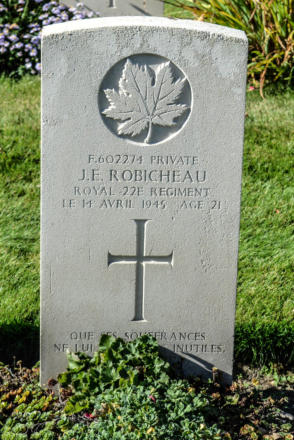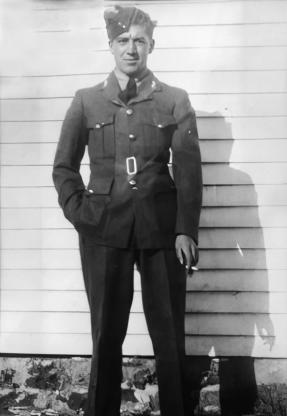
copyright © Wartime Heritage Association
Website hosting courtesy of Register.com - a web.com company
Wartime Heritage
ASSOCIATION
Remembering World War II
Name:
Joseph Edmond Robicheau
Rank:
Private
Service Number:
F/602274
Service:
Royal 22nd Regiment, Royal Canadian Infantry Corps
Date of Birth:
November 16, 1923
Place of Birth:
Meteghan, Clare, Digby County, Nova Scotia
Date of Enlistment:
August 5, 1943
Place of Enlistment:
Halifax, Halifax County, Nova Scotia
Address at Enlistment:
Meteghan, Clare, Digby County, Nova Scotia
Age at Enlistment:
19
Hair Colour:
Brown
Eye Colour:
Green
Occupation:
Fisherman
Marital Status:
Single at enlistment
Religion:
Roman Catholic
Next of Kin:
Vitaline Robicheau (Mother)
Date of Death:
April 14, 1945
Age:
21
Cemetery:
Holten Canadian War Cemetery, Netherlands
Grave:
Section III, Row A, Grave 8
Commemorated on Page 559 of the Second World War Book of Remembrance
Displayed in the Memorial Chamber of the Peace Tower in Ottawa on November 23
Joseph Edmond Robicheau was the son of Cesaire P. Robicheau (1874-1970) and Vitaline (Deveau)
Robicheau (1896-1984), of Meteghan, Digby Co. NS, and the brother of Marie Irene Robichaud (1917-
2007), Émile Robicheau (1919-2006), Stanis Robichaud (1922-2005), Jean-Louis Robicheau (1925-
1925), Marie Therese Robichaud (1926-2001), Alfred Robichaud (1930–2021), and Marie Sadie
Robichaud (1934-2014).
When he enlisted at the No. 6 National Resources Mobilization Act (NRMA) Clearing Depot in Halifax,
Nova Scotia, on August 18, 1943, he noted that he had worked as a fisherman for 2 years and had
served in the 2nd Battalion West Nova Scotia Infantry (Reserve) since October 1942.
On September 17, 1943, Edmond was sent to No. 61 Canadian Army Basic Training Centre (CABTC) in
New Glasgow, Nova Scotia for training as a gunner. After completing his basic training, he was attached
to A23 Training Centre in Halifax, Nova Scotia on November 16, 1943. A23 was a Coast and Anti-
Aircraft Artillery Training Centre established to train coast and anti-aircraft gunners.
On March 11, 1944, Edmond was transferred to the 16th (C) Regiment of the Royal Canadian Artillery
and sent to Sydney, Nova Scotia. Not long afterwards, on April 26, 1944, he was assigned to the 104th
Coast Battery of the Royal Canadian Artillery and posted to Shelburne, Nova Scotia.
The 104th Coast Battery was garrisoned at Fort McNutt on McNutt’s Island, as coastal defence to
protect the Navl base at Shelburne from the threat of German submarine activity.
On September 7, 1944, Edmond transferred to the Royal Regiment of Canada and sent for a 4-day
tactical training course at the Special Infantry Training Camp in Vernon, British Columbia on September
27, 1944.
On October 1, 1944, Edmond was attached to the 1st Battalion Oxford Rifles, part of the Royal
Regiment of Canada, which served in Canada in a home defence role as part of the 16th Infantry
Brigade, 8th Canadian Division.
On January 2, 1945, Edmond was among the soldiers of the 1st Battalion Oxford Rifles who left Canada
for the United Kingdom, arriving on January 8, 1945. The Battalion was disbanded on January 10,
1945, to provide reinforcements for the First Canadian Army.
Joseph transferred from the UK to Belgium on March 9, 1945, and was assigned to the Royal 22nd
Regiment on April 2, 1945, in Putte, Belgium.
In the Regimental history of the Royal 22nd Regiment, author Serge Bernier records that “on April 4,
the regiment made an incursion into the Reichswald, near Clèves, which the Canadians had recently
liberated at considerable cost.” Clèves is just across the Dutch border in Germany. After a few days,
the Regiment made its way back into The Netherlands. “… On the 10th the Royal 22e left the sector,
passing through Clèves and Emmerich, before moving into eastern Holland, and stopping near
Zutphen. On the 13th it crossed the IJssel [river] to take up a position in a bridgehead that the 3rd
Brigade would use as a base to attack the town of Appeldoorn”.
On April 14, 1945, the Regiment received orders. “The West Nova Scotia Regiment and the Carleton
and York Regiment were the first to leave, closely followed by the Royal 22nd Regiment, but at 7:30
am the regiment received orders to capture a well-defended wooded area...”. This became known as
the Battle of the Five Woods. “… Assisted by tanks, the companies performed mopping-up operations
in the sector for 24 hours. The assignment proved costly: 11 men were reported killed, 19 wounded
and two missing”.
Private Edmond Robicheau was among those killed
during the Battle of the Five Woods near Deventer,
Netherlands on April 14, 1945. He is interred at the
Holten Canadian War Cemetery, 20 kilometers from
Deventer.
Joseph Edmond Robicheau






- World War I - Menu
- WWI Stories and Articles
- Photos - Yarmouth Soldiers
- Selection of World War I Songs
- WWI Casualties of Yarmouth, NS
- Those Who Served - Yarmouth, NS
- WWI Casualties Digby Co. NS
- WWI Casualties Shelburne Co. NS
- Merchant Mariners (1915) Yarmouth, NS
- Canadian Forestry Corps - Non Yarmouth Birth/Residence Enlistments
- US Draft Registry - Yarmouth NS Born


- World War II - Menu
- WWII Stories and Articles
- Telegraphist Air Gunners
- WWII Casualties of Nova Scotia
- US Casualties with NS Connection
- Far East/Pacific Casualties with NS Connection
- Merchant Navy Casualties Nova Scotia
- Nova Scotia WWII Casualties Holten Canadian War Cemetery
- D-Day Casualties - Nova Scotia
- CANLOAN Program Casualties - Nova Scotia
- Battle of the Bulge Casualties - Nova Scotia
- WWII Casualties Yarmouth NS
- Yarmouth Casualties - RCAF RAF Canadian Army WWII
- Yarmouth Co., Marriages WWII
- Casualties Non-Born/Residents with Connection to Yarmouth Co., Nova Scotia.
- WWII Casualties Digby Co., NS
- Non-Nova Scotian WWII Casualties Buried in Nova Scotia
- WWII RCAF Casualties Aged 16-18
- Brothers/Sisters Who Served - World War II













